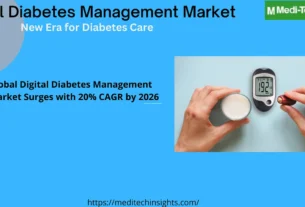The primary drivers of this market are the increasing prevalence of chronic diseases such as diabetes, cancer, and cardiovascular disorders; the growing use of digital pathology in research; the increasing incorporation of digital pathology in drug discovery and precision medicine programs; the growing acceptance of telepathology; and the adoption of digital pathology to improve efficiency and streamline laboratory operations.
Digital pathology refers to the collection, organization, dissemination, and analysis of pathology data, including slides and information, within a digital framework. Scanning glass slides using specialized instruments results in high-resolution digital pictures that may be downloaded and seen on computer displays or mobile devices.
Get A Free PDF Research Report of Digital Pathology Market : https://meditechinsights.com/digital-pathology-market/request-sample/
Rising Adoption of Artificial Intelligence in Digital Pathology Drives the Market
Artificial intelligence (AI) is transforming pathology by complementing established diagnostic approaches, increasing accuracy, and improving patient outcomes. This technology, which combines machine learning algorithms and deep learning techniques, has considerable potential in several areas of pathology, including diagnosis, prognosis and therapy planning. One of the most common uses of AI in pathology is the analysis of histopathology slides. Furthermore, AI allows for the integration of numerous data sources, such as genetic data and clinical information, to give detailed insights into disease pathology. For instance,
- In February 2024, Paige has announced a substantial expansion of its AppLab marketplace, including six additional digital pathology and AI suppliers. New apps will be introduced to the AppLab to assist pathology laboratories globally in developing completely integrated and customized AI-enabled workflows.
Growing integration of digital pathology in precision medicine drives market growth.
Digital pathology advances precision medical techniques by allowing for a detailed evaluation of tissue samples, biomarkers, and genetic information. The combination of digital pathology, electronic health records (EHRs), genetic profiling, and clinical decision support systems presents exciting opportunities for personalizing treatment methods to individual patients’ molecular profiles and illness features.
Rapid digitalization in pathology workflow promotes market growth.
The growing digitization of pathology workflows marks a paradigm shift in how pathology laboratories function, employing technology to streamline operations, increase efficiency, and improve patient care. With digital workflow, photos may be sent to pathologists, increasing both the speed of diagnosis and the quality of assessments. It also increases productivity by improving workflow distribution, information management, and data integration. Operational expenses are decreased since slides and accompanying documentation do not need to be transferred, and diagnostic delays can be minimized. Furthermore, the technology helps compensate for a dwindling pool of pathologists in the profession by distributing the task remotely to where pathologists are and enabling them to work more efficiently.
Key Challenges of the digital pathology market
Numerous challenges prevent widespread adoption of digital pathology, including the significant upfront expenditure required to develop infrastructure such as slide scanners, image processing software, and data management systems. Additional problems include technology limits, regulatory hurdles, recurrent maintenance costs, implementation complexity, and pathologists’ reluctance to adopt new technologies.
North America is expected to continue to have a major share of the digital pathology market.
Geographically, North America dominates the Digital Pathology Market. This is mostly due to advancements in whole slide imaging (WSI) technology, the increased frequency of chronic illnesses, and the expanding integration of digital pathology systems into current laboratory processes in the area.
Competitive Landscape
Some of the key players operating in the market are Paige, Corista, Danaher, Techcyte, and Leica Biosystems among others.
Organic and Inorganic Growth Strategies Adopted by Players to Establish Their Foothold in the Market
Players operating in this market are adopting organic and inorganic growth strategies such as launching new products, acquiring related firms, and entering into mergers & collaborations to garner higher market share. For instance,
- In February 2024, Proscia announced that they had received 510(k) clearance from the United States (U.S.) Food and Drug Administration (FDA) for its Concentriq AP-Dx. The digital pathology solution was cleared for primary diagnosis
- In March 2023, Paige and Leica Biosystems announced an expanded partnership to enhance the use of digital pathology workflows at hospitals and laboratories around the world
For more granular insights and customized research report : https://meditechinsights.com/digital-pathology-market/
About Medi-Tech Insights
Medi-Tech Insights is a healthcare-focused business research & insights firm. Our clients include Fortune 500 companies, blue-chip investors & hyper-growth start-ups. We have completed 100+ projects in Digital Health, Healthcare IT, Medical Technology, Medical Devices & Pharma Services.
Contact:
Ruta Halde
Associate, Medi-Tech Insights
+32 498 86 80 79


